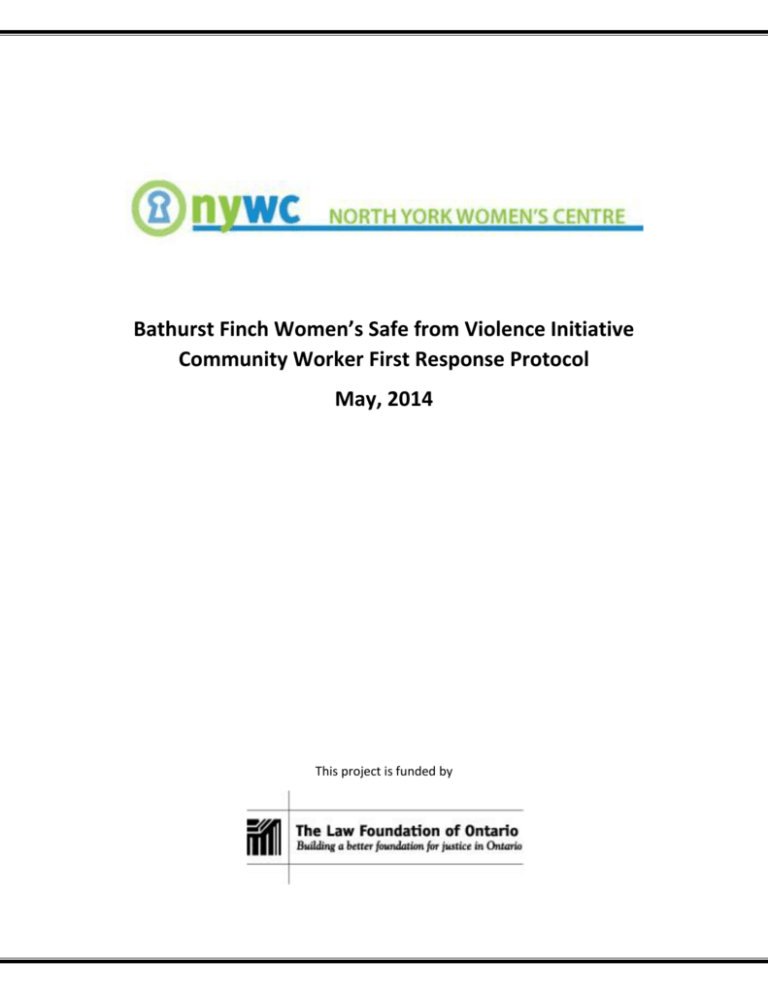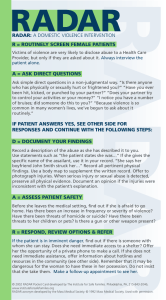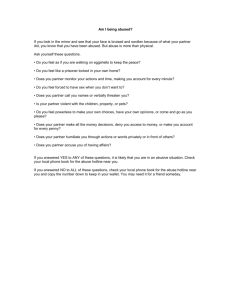Community Worker First Response Protocol
advertisement

Bathurst Finch Women’s Safe from Violence Initiative Community Worker First Response Protocol May, 2014 This project is funded by Table of Contents Introduction .......................................................................................................3 Purpose ..............................................................................................................3 Principles and Best Practices ...............................................................................3 First Response Protocol Steps 1. Identifying Abuse .....................................................................................5 2. Responding to a Disclosure .......................................................................5 3. Initial Assessment a) Risk Assessment and Safety Planning ............................................6 b) Health Needs ................................................................................7 c) Support Systems ...........................................................................8 d) Legal Assistance ............................................................................8 e) Financial Support ..........................................................................9 Conclusion .........................................................................................................10 Recognition and Thanks .....................................................................................10 2 Introduction This protocol was prepared as part of the Bathurst Finch Women’s Safe from Violence Initiative (BFWSV). BFWSV projects are designed to enhance services and supports to women experiencing or at risk of domestic violence and build a safer, more empowering community for women in Bathurst Finch. While domestic abuse occurs in all communities, this project focuses on the Bathurst Finch Community Services Hub, where 13 social services agencies have colocated to provide accessible services to this community including language and culture-specific settlement supports and programs. A woman’s first disclosure about an abusive situation at home may be to a frontline worker that she respects and trusts, but this worker may not have special expertise in handling domestic violence issues. These workers, especially when they can speak a woman’s first language and have an understanding of her cultural norms, can provide important one-on-one support to women and are in a unique position to connect women to the most appropriate services in the community. We want to ensure that abused women receive responsive support, information on their options and appropriate referrals to the services they need regardless of where they begin. We want to be sure front-line workers know how to respond to women with abuse issues, and how to connect them with specialist intervention and case management by qualified people in agencies mandated to deliver specialized domestic violence services. This resource was created for and by community workers in Bathurst-Finch based on what is important to them. You are free to download or re-print this information for your own use. Purpose The protocol has been prepared to help workers: Respond with sensitivity Help increase a woman’s safety Provide information on resources and options Make effective, timely referrals to specialized services and supports Encourage women to take action to stop the violence and to begin steps towards positive changes in their lives. This guide is not intended to replace an agency’s own policy, service plan or referral procedure. 3 Principles and Best Practices During development of this resource, guiding principles that reflect respected approaches and proven practices were captured from consultations with people who work in the Violence Against Women community. These are summarized below: Commitment to anti-racism, anti-oppression and feminist principles is essential. This framework recognises that race, age, ethnicity, immigration status and linguistic barriers reflect a power imbalance that makes women and children susceptible to abuse. While cultural practices and traditions may offer unique resources and problem-solving approaches, cultural and religious communities differ significantly in their responses to family violence and the supports they provide to women. Some women do not wish to connect with their communities when dealing with violence and abuse. Disability, lack of financial means, immigration status, and language issues all add to the complexity of the challenges a woman faces. No one worker or organization can fully address the whole problem of woman abuse. It is through advocacy, collaboration, and integration of a combination of supports that women gain the strength, knowledge, support and resources they need. Raising awareness of human rights, legal rights and equality issues helps all to recognize the importance of women’s independence and freedom from violence. As community workers, we recognize that: We have our own personal values, cultural beliefs and assumptions related to woman abuse that can impact the way we respond. Because are not always aware of biases we hold, it is an ongoing challenge to check our attitudes and behaviours for bias. We need to work within our personal comfort level and boundaries. We need to work within our level of skill and responsibility. We need to work within the mandates and guidelines of the organizations we work for. We can best serve women when we: Respond to current challenges as each woman describes them, listen actively and validate her concerns. Recognize that the cycle of violence contributes to a woman’s isolation and loss of confidence. Help women build and rebuild their strengths and increase their sense of competency. Provide information about rights, services and support options for her consideration. Assist a woman to help herself. Support her to make her own decisions. Help her develop ability to deal with other situations she may encounter in the future. 4 First Response Protocol Steps 1. Identifying Abuse As a worker, you may suspect a woman is experiencing abuse. She may appear to be covering bruises; she may cancel meetings at the last minute or appear sad, lonely, afraid or withdrawn. She may not want you to call her at home or leave messages. She may be reluctant to a talk about abuse and initially present a different problem (by asking questions about subsidized housing, for example) or she may speak about someone else who is experiencing abuse. Legal clinics and other service providers may receive inquiries from women about related legal matters. They may ask about family law, child protection or immigration status that could indicate concerns about domestic abuse. Provide opportunities for her to tell her story in her own way. Questions you may ask to encourage her to talk with you are: Are you in a relationship with someone who threatens to hurt you or has hurt you? Do you have concerns about your safety? Do you have concerns about your children’s safety? Are you concerned about the impact of your partner’s behaviour on your children? Are you afraid of your partner? 2. Responding to a Disclosure If a woman discloses that she is experiencing abuse, your first steps should determine her immediate safety. Respond to the disclosure right away. Is she in a safe place? If you are talking by phone, first find out if the woman is in a safe place to talk with you. Is she in immediate danger? If she is in immediate danger, she should call 911. Language interpretation is available for many languages. The police will come and may lay charges when there are reasonable grounds to believe an offence has occurred. The police, with permission, can call the Victim Crisis Assistance and Referral Services (VCARS). VCARS staff and volunteers provide onsite assistance, needs assessment and services such as emotional support, financial assistance through the Victim Quick Response Program and referral to community agencies. The Victim Services Crisis line can be called directly at 416-808-7066. 5 Women can also call the Assaulted Women’s Helpline for assistance over the phone in over 150 languages at 1-866-863-0511. This free and confidential service is available 24 hours a day seven days a week. Services include telephone crisis counselling, information and emotional support, and referrals to emergency shelters, legal support and community services as well as culturally appropriate resources for abused women. If she is not in a safe place but is not in immediate danger, encourage her to: Go to a safe place (relative, trusted friend or neighbour). Go to a women’s shelter, women’s centre, your own facility or another safe community space and get help. Once a woman is in a safe place, an initial assessment of her situation should be done. 3. Initial Assessment The first meeting with a client who has disclosed abuse must demonstrate a caring and effective response by: Providing an environment that is safe and comfortable for disclosure. Arranging for interpretation if required. Demonstrating through verbal and non-verbal feedback that you are listening and are concerned Validating a woman’s fears and feelings. Not minimizing in any way her experience and its impact. Providing opportunities for her to express her needs and how she sees her strengths and options. Expressing that you want to work with her to increase her safety and well-being. Letting her know some notes may be taken. Identifying any child protection concerns. Explaining that you are required under the Child and Family Services Act to report any suspicions that a child may be physically, sexually or emotionally abused. Explaining confidentiality, information that will be disclosed and to whom according to organizational policies. The focus of this initial meeting is to identify priorities, provide information about choices and steps and if she decides to take action, to connect the women to specialized services. Find out what she has tried already and validate her experience. Get the woman’s permission before taking action on her behalf and respect her right to make her own choices. 6 Components of Initial Assessment a) Basic Safety Planning and Risk Assessment A woman who has experienced abuse may chose to remain in a potentially abusive situation. Help her find ways to take some control of her situation. Advise the woman that her safety and her children’s safety can be increased. Encourage her to develop a safe escape plan that includes where she will go to be safe. At minimum she should try to put aside some money, keep identification and other official documents in a safe and accessible place, and prepare some notes about how and when the abuse happened and keep these notes in a safe place. Make sure her support system includes people who understand woman abuse and that she knows who to contact if she is in need of help. Provide contact information for crisis lines, shelters and community services that support abused women. Some women may not fully realize the danger they face. All service providers should be aware of the risk factors associated with lethality. If a woman answers yes to any of the following questions, she is at risk of severe harm. Has he/she threatened to kill you or your children? Has he/she ever used a weapon against you or threatened you with a weapon? Do you think he/she might try to kill you? Is there a recent or pending separation? (These questions are based on a short lethality risk assessment provided by the GuelphWellington Community Protocol on Sexual Assault and Domestic Violence). In-depth Specialized Risk Assessment and Safety Planning If any of the above factors are present, a comprehensive risk assessment and full safety plan should be done by specially trained personnel. Community workers may arrange this by contacting one of the agencies below. Victim Services High Risk Support Program The Victim Services Program of Toronto provides support for women at high risk who are living with their abuser. Risk assessment and safety planning is provided along with case management support and advocacy for victims to navigate their way through the court system, community and government services. This service can be arranged through the Victim Services Crisis Line at 416-808-7066. 7 Transitional Support and Housing Workers Transitional Support Workers provide on-going case management including risk assessment, crisis intervention, transition and safety planning. These workers may also assist the woman to obtain safe and affordable housing apart from their abuser and access supports and services to establish themselves in violence-free lives. Two agencies offering the Transitional Support Program for North York women are: North York Women’s Shelter 416-635-9427 ext 221 Yorktown Shelter for Women 416-394-2950, ext 236 b) Health Needs For immediate medical care a woman can go to any hospital emergency department. Emergency departments may refer her to a Sexual Assault and Domestic Violence Program at Scarborough Hospital or Women’s College Hospital for services which may include: Medical assessment Collection of medical evidence Forensic documentation including photography Psychological and counselling support Safety planning, referrals Follow-up clinic (Scarborough Hospital) Cultural interpreters (Women’s College) Scarborough Hospital Sexual Assault and Domestic Violence Care Centre 3030 Birchmount Road 416-495-2555 Women’s College Hospital Sexual Assault and Domestic Violence Care Centre 76 Grenville Street (Yonge and College area) 416-323-6040 Abuse impacts physical, emotional and mental health. Women can be encouraged to see their family doctor, social worker or public health nurse for help dealing with less urgent physical or psychological concerns. It is a good idea to have her write down details of abuse (if threatened, what was said, if injured, exactly where and how, any witnesses). If there are addictions or mental health concerns, make sure these issues are addressed and that she is connected to relevant services. Family Services Toronto provides counselling services, workshops and support groups for women at different locations in the city. Call 416-595-9618 for current information. 8 c) Support Systems Ask about her existing support system and if she is involved in any community programs or groups within her culture or local community. Make sure she knows who she will contact if she is in need of assistance. Recommend that she include people and agencies that understand woman abuse and how the trauma of abuse affects women’s lives. Assist her to build a support system that will help her move forward. The company of a supportive person can make a big difference to her progress. Provide information on local groups that empower women and activities that could extend and strengthen her support system. d) Legal Assistance Legal Information Many women find it helpful to educate themselves about their rights and options. Excellent online and print resources on legal rights and options are available in many languages. Websites that offer free resources and links to order printed materials are: Community Legal Education Ontario http://www.cleo.on.ca/ Your Legal Rights http://yourlegalrights.on.ca/ Family Law Education for Women http://www.onefamilylaw.ca/ Criminal Law An abused woman may require legal assistance to get protection orders to keep her partner away from her or if criminal charges have been laid against the abuser. The Victim Witness Assistance Program (416-314-2447) helps women understand the criminal court system and what to expect during different court procedures. Family Law If the relationship is ending, legal advice from a lawyer who knows family law can help a woman gain a better understanding of her rights and options with respect to spousal and child support, possession of the family home and division of assets. For women who cannot afford a lawyer, information about court, family law, referrals to lawyers and legal forms, women can visit Family Law Information Centres at family courthouses across Toronto. Because these centres are often very busy, women are advised to organize their documents and questions ahead of time and to be prepared to wait for assistance. http://www.attorneygeneral.jus.gov.on.ca/english/courts/Court_Addresses/ 9 North York also has a Family Law Service Centre (416-730-0936) which helps clients who meet Legal Aid Ontario requirements to navigate the family court system. Immigration Law Abused women with immigration or refugee issues should be referred to an immigration lawyer with an understanding of family law. Women who have left abusive relationships may find themselves involved in more than one legal system at the same time. Legal support and advice from credible sources is needed to deal with the challenges and delays that may occur. Legal Advice Those with low incomes may obtain help in from Legal Aid Ontario. Workers can assist a woman who meets eligibility requirements to obtain a legal aid certificate that can be used to obtain advice from a lawyer. www.legalaid.on.ca 416-979-1446 Justice Net is a non-profit service that connects low and moderate income Canadians with legal professionals who offer their services at a reduced fee. www.justicenet.ca 416-479-0552 The Law Society Referral Service can provide names of lawyers who will give a free short consultation to determine legal rights and options. They can also provide names of lawyers who accept legal aid. www.lsuc.on.ca 416-947-3300 Record Keeping Encourage her to write notes about the details of violent incidents, threats, and other abusive behaviour. She should include any potential witnesses (daycare workers, neighbours, health care workers). Emails, text messages and photos of injuries may also be useful. A simple notebook with dates and details of what occurred can provide valuable evidence. These records (chronological if possible) should be kept in a safe place in case they are needed for legal proceedings. 10 e) Financial Support For women in financial need, Ontario Works can provide temporary financial support and help finding a job. http://www.mcss.gov.on.ca/en/mcss/programs/social/ow/. Women in abusive situations will be met in a safe place within 24 hours of contacting Ontario Works. They will not be asked to get financial support from their abusers. 11 Conclusion Community workers without expertise in woman abuse can and do perform important roles as trusted intermediaries for women, by providing initial support, clarifying issues and giving information on steps to take while protecting confidentiality. It is important for all women to know that they have rights and options and that they can keep themselves safe and improve their lives. It is important for workers to know that they can point women towards steps to self-reliance and better futures. Recognition and Thanks We thank the many volunteers and staff from Bathurst Finch hub agencies who provided information and feedback during the preparation of this resource. Bathurst Finch Hub Agencies Big Brothers Big Sisters of Toronto Circle of Care CUIAS (Canadian Ukrainian Immigrant Aid Society) Downsview Community Legal Services Downsview Services for Seniors Family Service Toronto JVS Toronto Kababayan Community Centre Multicultural Services KCWA Family and Social Services North York Community House North York Women’s Centre (NYWC) Toronto Public Health Unison Health and Community Services








